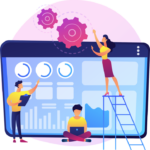5 things to keep in mind when planning an online staff development course
With work-from-home and hybrid-week staff working in scattered locations, offering effective corporate training can feel like trying to herd cats.
But online education is a great way to ensure staff receive the training and upskilling they need to stay compliant and flourish in their roles, regardless of location or work schedule.
Companies are moving towards online staff development by using a learning management system (LMS). Choosing an LMS for your staff development course offers an innovative learning experience for learners and easy progress monitoring for you.
When developing staff training courses, it’s important to keep the elements below in mind. They’ll help your course stay focused and fruitful for your staff, avoid employee training scope creep, and deliver course material that keeps learners engaged.

Remember why corporate training – especially online – is essential
Before planning a practical staff development course, it helps to remind yourself why corporate training is critical for your employees and company to thrive.
Companies who invest in corporate training see:
- Higher revenue and income
- Skilled employees perform their roles more effectively
- Better staff retention rates and lower attrition costs
Online training, specifically, offers unique benefits to companies. When staff undergoes development courses online, companies and staff gain:
- Better retention of information
- Faster training than in-person courses
- Consistent, standardised training courses for all employees
- Flexible training staff can complete at their convenience
Plus, with monitoring and reporting functionality, an LMS allows you to track your employees’ progress and manage training reports from one location.
Set learning goals for your employee training

The key to any successful training course is clearly-articulated learner goals. At the end of a course, learners should be able to state precisely what they learned and how that information is advantageous to them in their job roles.
To meet learner goals, you first must set them. Think about the purpose of the training and your audience. New employee training will have different goals than compliance training, and current staff development courses will be different again.
The beauty of using an LMS to create each module is that you can easily tweak the goals and content for each learner group. Creating multiple training courses is streamlined, as is sending the right training materials to each group within the LMS.
Create staff development content that supports your goals
When you use an LMS to create your employee training, creating specific training courses for specific goals is fast and straightforward.
You can include detailed content that’s highly relevant to each learning group. There’s no need for generic, one-size-fits-all training content that is repetitive for some employees and not detailed enough for others.
Instead, your staff development content is tailored to each learning group. That makes it more engaging for learners, who are more likely to retain the information they learned.
Choose the learning management system that fits your goals best
Another way to make learning engaging is to use an LMS that caters to various learning styles. Your employees will likely want a learning environment that supports the following:
Mobile learning
No matter where your employees conduct their training, it’s likely that they’ll use a mobile device instead of a computer. Make sure your LMS offers your workforce a mobile learning option.
Community learning
Most staff members, especially those working remotely, welcome any opportunity to create deeper connections with their colleagues. An LMS that allows community building encourages learners to ask questions, share answers or problems, or simply chat in an online discussion forum.
Gamification
You can keep staff development exciting by adding gamification elements. The right LMS will allow you to incorporate badges, contests, and awards to make employee training more engaging and fun.
Personalised learning
A worthy LMS will allow you to personalise landing pages and dashboards for different learning groups. You may also want to build different learning paths within each training course.
It’s essential to choose an LMS with an intuitive UX/UI interface so that users feel comfortable in the learning environment and want to explore it. If the UX/UI is clunky or unappealing, users will find it distracting to learn and harder to retain information.
Ask for learner feedback on your employee training program

In a dynamic corporate environment, your training material should evolve and improve with each staff development course.
Your LMS should allow space for learner feedback at the end of each course. The information you gather from your employees is critical to tailoring your future staff development courses and fine-tuning the content.
You can create polls within an LMS to understand which parts of your employee training work well and which parts need improvement.
In an LMS, your poll and feedback results are stored indefinitely, and you can easily create reports from the results. That way, you’ll have concrete data about the effectiveness of your staff development courses and an actionable roadmap for their future.
If you’d like a demo of LearnRight, book a free one today. We’re happy to show you how LearnRight’s LMS delivers everything your staff expects in an online training course and everything you need to create and monitor an effective one.







